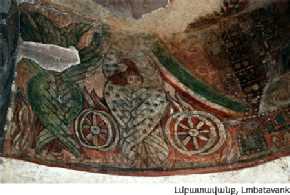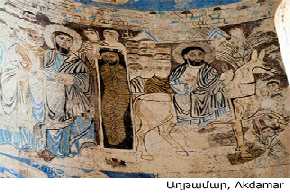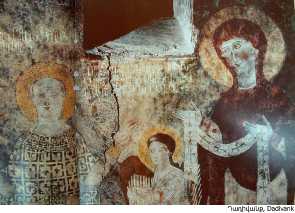Armenian Murals
 Mural/Fresco – is one of the oldest and most unique expressions of the Armenian Finearts, as an inseparable part of the Armenian Architecture yet, one of the poorly, preserved and researched. Its ruin, and some times complete disappearance are due to human intervention a long with nature, the climate, which have heavily affected this very delicate form of the fine arts. The Armenian Mural Art of the middle ages is specifically, notable. We have its relatively, poor or well preserved samples in Armenia, Historic Armenia, and the Armenian diaspora both old and new.
Mural/Fresco – is one of the oldest and most unique expressions of the Armenian Finearts, as an inseparable part of the Armenian Architecture yet, one of the poorly, preserved and researched. Its ruin, and some times complete disappearance are due to human intervention a long with nature, the climate, which have heavily affected this very delicate form of the fine arts. The Armenian Mural Art of the middle ages is specifically, notable. We have its relatively, poor or well preserved samples in Armenia, Historic Armenia, and the Armenian diaspora both old and new.
Theveryold, falseidea, that the Armenian church has allegedly refused doctrinal considerations, and that the existing murals in the Armenian church belong to other doctrine, Chalcedon, (namely the Byzantine and the Georgian), was another reason for the lack of research on the Armenian murals. Although, Later in the mid 20th, century, this false view was scientifically, denied mainly by the research and long studies of Sirarpi Der Nersesyan (1896-1989), and Lidia Durnovo ( 1885 - 1963 ). Their proof included “source references”, and research results from the original monument and murals studies, concluding that regardless the disputes between the Armenian and the Byzantines churches, several of the the Armenian church in the 5th, - 7th, centuries, had murals, (for example: Lmpadavan, Mren, Aruch, Talin, Kosh, Yeghvart, etc.), and that this tradition has continued in the future centuries, (for example: Tatev, Aghtamar, Haghbad, Horomos, Sourp Prgitch (St. Savior) in Ani, Dadivank, Geghart etc.).
In the 13th, century the Chalcedon murals emerged, specifically, in the churches and monasteries that belonged to the Armenian Zakaryan Princes, who served as high ranking officials in the Georgian state and eventually, converted to the Chalcedon doctrine (for example: Akhtala, Qobayr ).
However, the Armenian Chalcedon church murals are limited to the 13th, century. While in the later centuries, in Armenia and the diaspora churches the murals covered the walls of the Armenian churches, (for example, and specifically, Cyprus, Crimea, Nor Tchougha (New Joulfa), Tbilisi, Lvov, etc.). This form of the Armenian fine arts, has continued to bloom through the 17th, century Armenian churches and monasteries, ( for example: Sourp Etchmiadzine (Holy Etchmiadzine9, The Amenaprgitch of Hin Dchougha (Old Joulfa), Asdabad, Agoulis, Varagavank (Varaga monastery), St. George of Moughni, Meghri, etc ), and it has continued to our days.

















